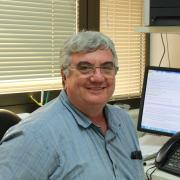Associate Professor, Department of Clinical Microbiology and Immunology, Sackler Faculty of Medicine, Tel Aviv University
Director, Sackler Cellular and Molecular Imaging Center (SCMIC)

Associate Professor, Department of Clinical Microbiology and Immunology, Sackler Faculty of Medicine, Tel Aviv University
Director, Sackler Cellular and Molecular Imaging Center (SCMIC)
1991-1994 פוסט דוקטורט, מרכז לחקר הסרטן הלאומי ( (NCI, המרכז הלאומי לבריאות(NIH) , מרילנד, ארה"ב.
1994-2010 מרצה בכיר, מיקרוביולוגיה קלינית ואימונולוגיה, סאקלר, אוניברסיטת תל-אביב.
2000-2002 חוקר אורח ומנהל מחקר במרכז לדימות מולקולרית של מכון ואן-הנדל ואוניברסיטת מישיגן.
היום -2010 פרופ' חבר, מיקרוביולוגיה קלינית ואימונולוגיה, סאקלר, אוניברסיטת תל-אביב.
סרטן השד היא מחלה שמקורה בשד, אך היא עלולה לשלוח גרורות אל איברים שונים בגוף ולגרום למותן של החולות. בשלביה הראשוניים המחלה מתאפיינת בגידולים מקומיים בשד, לאחר מכן חודרים תאים סרטניים לקשרי הלימפה של בית השחי ומשם עלולים התאים לחדור לזרם הדם ודרכו להגיע לאיברים מרוחקים כגון הכבד, הריאות והמוח. המחלה מתפתחת בעיקר בנשים מעל גיל חמישים והיא נדירה בגברים ונשים צעירות.
המחקר במעבדתי מתרכז בהבנת המנגנונים המולקולריים והתאיים המובילים להתפתחות גרורות בחולות סרטן שד. המחקר מתמקד בהבנת תפקידם של האונקוגן Met והגן המטבולי Mimp/Mtch2, שבודד לראשונה במעבדתנו, בהתפתחות סרטן שד. במעבדתנו יצרנו מספר מערכות מודל עכבריות ייחודיות להערכת השפעתם של Met ו- Mimp/mtch2 על התפתחות גרורות. במחקר זה אנו מפתחים ומשתמשים בשיטות דימות מולקולרי מיקרוסקופי ומקרוסקופי מתקדמים ביותר. תרופות המעכבות את פעילותו של Met נמצאות בשלבים שתים ושלוש של ניסויים קליניים. אנו מפתחים ובוחנים טיפולים חדשניים כנגד סרטן השד. טיפולים אלו מבוססים על עיכוב פעילות Met, כימותרפיות חדשניות וכן שיטות להתאמה אישית של הטיפול לחולה.
פרסומים אחרונים
46. Zaritsky, A., et al. Cell motility dynamics: a novel segmentation algorithm to quantify multi-cellular bright field microscopy images. PLoS One 6, e27593 (2011).
47. Shaul, P., et al. The Structure of Anthracycline Derivatives Determines Their Subcellular Localization and Cytotoxic Activity. ACS Medicinal Chemistry Letters 4, 1 (2012).
48. Stein, G.Y., et al. Met kinetic signature derived from the response to HGF/SF in a cellular model predicts breast cancer patient survival. PLoS One 7, e45969 (2012).
49. Tsarfaty, I. & Ben-Jacob, E. Secrets of tubule engineering by epithelial cells. Proc Natl Acad Sci U S A 109, 6790-6791 (2012).
50. Zaritsky, A., Natan, S., Ben-Jacob, E. & Tsarfaty, I. Emergence of HGF/SF-induced coordinated cellular motility. PLoS One 7, e44671 (2012).
51. Laser-Azogui, A., Diamant-Levi, T., Israeli, S., Roytman, Y. & Tsarfaty, I. Met-induced membrane blebbing leads to amoeboid cell motility and invasion. Oncogene (2013).
פרסומים נבחרים מהעבר
1. Tsarfaty, I., et al. The met proto-oncogene receptor and lumen formation. Science 257, 1258-1261 (1992).
2. Tsarfaty, I., et al. The Met proto-oncogene mesenchymal to epithelial cell conversion. Science 263, 98-101 (1994).
3. Firon, M., et al. Dominant negative Met reduces tumorigenicity-metastasis and increases tubule formation in mammary cells. Oncogene 19, 2386-2397 (2000).
4. Kaplan, O., Firon, M., Vivi, A., Navon, G. & Tsarfaty, I. HGF/SF activates glycolysis and oxidative phosphorylation in DA3 murine mammary cancer cells.
Neoplasia 2, 365-377 (2000).
5. Yerushalmi, G.M., Leibowitz-Amit, R., Shaharabany, M. & Tsarfaty, I. Met-HGF/SF signal transduction induces mimp, a novel mitochondrial carrier homologue, which leads to mitochondrial depolarization. Neoplasia 4, 510-522 (2002).
6. Leibowitz-Amit, R., et al. Mimp, a mitochondrial carrier homologue, inhibits Met-HGF/SF-induced scattering and tumorigenicity by altering Met-HGF/SF signaling pathways. Cancer Res 66, 8687-8697 (2006).
7. Moshitch-Moshkovitz, S., et al. In vivo direct molecular imaging of early tumorigenesis and malignant progression induced by transgenic expression of GFP-Met. Neoplasia 8, 353-363 (2006).
8. Tsarfaty, G., et al. HGF/SF increases tumor blood volume: a novel tool for the in vivo functional molecular imaging of Met. Neoplasia 8, 344-352 (2006).
9. Golan, M., et al. Human endogenous retrovirus (HERV-K) reverse transcriptase as a breast cancer prognostic marker. Neoplasia 10, 521-533 (2008).